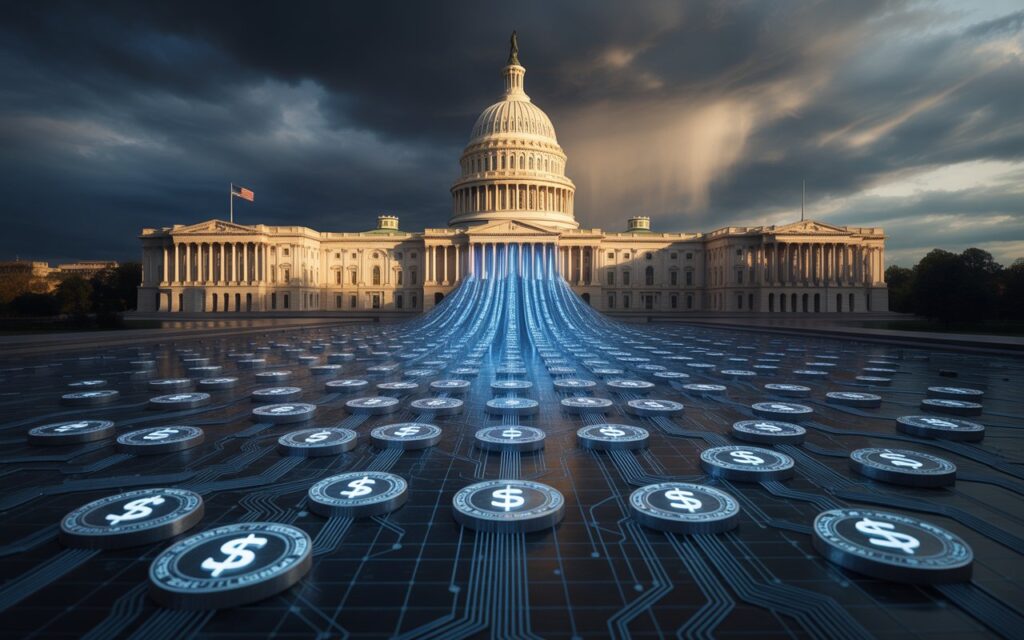
From Rebellion to Regulation
When Bitcoin first emerged in 2009, it was a declaration of independence – a peer-to-peer challenge to state-controlled money. Decentralized Finance (DeFi), a decade later, carried that torch further, aiming to eliminate intermediaries, banks, and government control.
But as we enter 2025, that dream is undergoing a remarkable transformation. The same governments once wary of digital currencies – particularly the United States – are now mastering the art of integration instead of suppression. Through stablecoins, Washington has discovered a mechanism not just to coexist with crypto, but to reassert its dominance in global finance.
The most telling symbol of this quiet revolution is the GENIUS Act (2025) – the first federal framework for payment stablecoins. Far from banning crypto, it formalises it under U.S. oversight, effectively turning private stablecoin issuers into digital extensions of the U.S. Treasury.
The Engineered Link: Stablecoins and U.S. Treasuries
Stablecoins were designed to maintain a 1:1 peg with the dollar, offering the speed of crypto and the stability of fiat. Yet their backing mechanisms have woven them directly into the fabric of U.S. government debt.
- Tether (USDT) now holds more than $171 billion in U.S. Treasuries as of 2025, making it one of the largest non-sovereign holders of American government debt.
Tether’s transparency reports reveal that the majority of its reserves are short-term U.S. Treasury bills, repurchase agreements, and cash. - Circle (USDC), the second-largest stablecoin issuer, holds about $50 billion in Treasuries through the Circle Reserve Fund, managed by BlackRock and detailed on the Circle Reserve Transparency page.
Together, these two companies represent over $220 billion in U.S. debt exposure – a staggering figure that effectively ties the health of the crypto economy to the stability of U.S. fiscal policy.
A Policy By Design
This connection is no accident. The GENIUS Act, signed into law in July 2025, explicitly mandates that all payment stablecoins must be fully backed by “high-quality liquid assets”, including U.S. dollars and short-term Treasuries.
You can read the legislative summary on the U.S. Congress website.
This isn’t mere oversight – it’s strategic absorption. The U.S. government has institutionalized a system in which stablecoin growth automatically fuels demand for its debt, creating a new digital feedback loop of dollar dominance.
DeFi’s Identity Crisis: From Decentralisation to Digital Dollar
The irony is hard to ignore. DeFi – the banner of financial independence – is increasingly dependent on centralised, regulated stablecoins as its primary source of liquidity.
Stablecoins like USDT and USDC have become the core collateral in DeFi protocols such as Aave, MakerDAO, and Uniswap, making them the backbone of an ecosystem that once prided itself on decentralisation.
- According to DefiLlama, more than 70% of all DeFi collateral now consists of centralised stablecoins.
- Transactions across major blockchains -Ethereum, Tron, Solana -are dominated by stablecoin transfers rather than native tokens.
This shift transforms the philosophy of DeFi. What began as a rebellion against central authority has become a new form of digitised compliance.
Even the ethos of “code is law” has given way to smart contract regulation, where stablecoin issuers can freeze, blacklist, or reclaim tokens under government orders.
For instance:
- Circle has frozen over $100 million worth of USDC in wallets associated with sanctioned entities or illicit activities, as publicly confirmed on its compliance blog.
- Tether, too, has engaged in asset freezes to comply with OFAC sanctions.
These actions demonstrate a new hybrid model– “RegFi”-where regulation is coded directly into financial infrastructure.
Washington’s Strategic Pivot: Taking Over, Not Tearing Down
For years, Washington’s approach to crypto was fragmented – marked by SEC lawsuits, congressional confusion, and interagency turf wars. That era is ending.
The GENIUS Act signals a clear shift from confrontation to consolidation. Instead of introducing a Central Bank Digital Currency (CBDC), which faced privacy and political opposition, the U.S. has chosen to privatise the digital dollar – using licensed stablecoin issuers as proxies.
Why This Strategy Works
- Political Plausibility: Unlike a CBDC, stablecoins are already accepted by the market. They don’t require direct Federal Reserve accounts for citizens.
- Regulatory Leverage: Through the new federal licensing model, issuers must comply with Bank Secrecy Act (BSA) and Know Your Customer (KYC) obligations, integrating them into the existing financial surveillance regime.
- Global Reach: Stablecoins extend dollar influence into unbanked and inflation-hit economies – from Argentina to Nigeria – where traditional banking rails fail.
As Treasury Secretary Janet Yellen remarked during the Act’s signing ceremony, the new framework “ensures that innovation strengthens, rather than undermines, the stability of the U.S. financial system.”
In practice, that means stablecoins are no longer outsiders; they are instruments of U.S. policy.
The Global Chessboard: De-dollarisation vs. Digital Domination
The rise of stablecoins coincides with the geopolitical trend of de-dollarisation efforts by countries like China, Russia, and the broader BRICS bloc to reduce dependence on the dollar.
The BRICS Countermove
- China has accelerated deployment of its digital yuan (e-CNY), used in cross-border transactions through the mBridge project.
- India continues pilot testing of its digital rupee, while Russia expands its digital rouble for sanctioned trade.
- BRICS members are developing alternative payment systems like CIPS and the proposed BRICS Pay, aiming to bypass SWIFT and dollar-based settlements.
However, these systems still lack the liquidity, global acceptance, and deep capital markets that underpin the U.S. dollar.
Meanwhile, stablecoins – most denominated in dollars – are exporting dollar liquidity globally through blockchain rails. This decentralised infrastructure extends the reach of U.S. monetary policy, often without direct intervention.
As one analyst from the Atlantic Council observed, “Stablecoins have become the digital tentacles of dollar dominance, reaching into markets the Federal Reserve cannot.”
DeFi vs. Regulation: The Ideological Battle
The GENIUS Act has drawn sharp criticism from the DeFi community. To purists, it represents the death of true decentralisation – where permissionless systems are replaced by permissioned gateways controlled by government-approved issuers.
Key Concerns Among DeFi Advocates
- Loss of Financial Privacy: Regulated stablecoins can track and freeze user transactions.
- Centralisation of Power: Only licensed entities can issue stablecoins, stifling innovation and competition.
- Surveillance Risks: Wallet-level monitoring could extend the state’s ability to track digital flows globally.
Projects like MakerDAO are already pivoting. In late 2024, Maker diversified its reserves to include real-world assets (RWA) such as tokenised loans and bonds, attempting to maintain autonomy from U.S. policy shifts.
Yet even these “decentralised” innovations are entangled with real-world regulation. As tokenised U.S. Treasuries dominate RWA markets, DeFi is, paradoxically, tokenising the very instruments of state finance it once sought to escape.
A Quiet Takeover, Not a Ban
It’s tempting to view the GENIUS Act and related frameworks as heavy-handed regulation. But in reality, they reflect a strategic adaptation – a way for Washington to preserve control over a system that was slipping beyond its reach.
Instead of building a government-controlled CBDC, the U.S. has opted for a federated model of control, outsourcing digital currency issuance to the private sector while retaining regulatory sovereignty.
In effect, the U.S. has built a programmable dollar system:
- Fully backed by U.S. Treasuries
- Managed by private issuers like Tether and Circle
- Supervised by federal regulators
- And accepted globally via decentralised networks
This system allows the government to extend the dollar’s influence digitally, sustain debt demand, and monitor global flows – without directly operating the infrastructure.
The Future of DeFi: Integration or Resistance?
The question now isn’t whether DeFi will survive government regulation, but how deeply it will be integrated into state finance.
Industry leaders are split:
- Some argue that regulation will legitimise DeFi, opening doors to institutional capital and mainstream adoption.
- Others fear it will sterilise innovation, replacing open systems with centralised gatekeeping.
Yet the direction of travel is unmistakable. The boundaries between crypto and state finance are blurring, giving rise to what economists call “Regulated DeFi” (RegFi) – a hybrid ecosystem where compliance and innovation coexist.
As of Q3 2025:
- Over 80% of DeFi transaction volume involves assets linked to U.S.-regulated stablecoins.
- Tokenised government securities on-chain surpassed $25 billion, led by firms like Franklin Templeton and WisdomTree.
- Institutional DeFi platforms, such as J.P. Morgan’s Onyx and Citi’s Regulated LiFi, are building permissioned blockchain networks aligned with regulatory standards.
The decentralised revolution, in other words, has evolved into a digitally regulated ecosystem.
Conclusion: Decentralisation Reimagined
DeFi promised freedom from the state, but the state has learned to speak DeFi’s language.
Through the GENIUS Act and its stablecoin mandates, the U.S. has found a way to:
- Channel global demand for its debt through digital currencies;
- Maintain dollar dominance in an era of de-dollarisation;
- And regulate the crypto ecosystem from within, not from above.
In doing so, Washington has achieved something no government has before: it didn’t destroy crypto- it absorbed it.
The story of stablecoins is, therefore, not one of rebellion but redirection – where the ideals of decentralization have been reshaped into a powerful tool of U.S. financial strategy.
As DeFi matures, the ultimate paradox remains: the closer it gets to changing the system, the more it becomes part of it.


